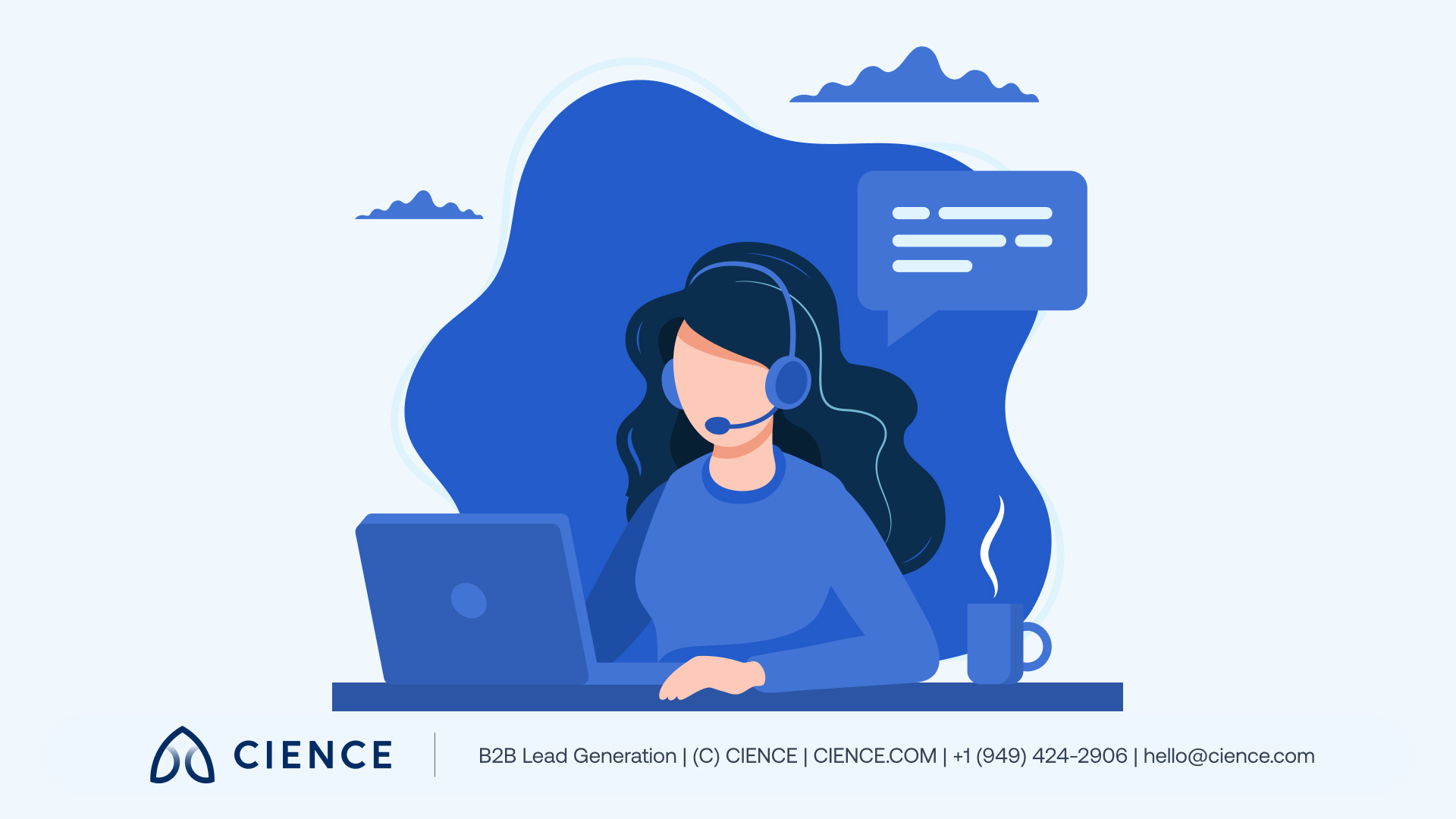A Day in the Life: SDR Caller
Back in the day, salespeople did everything: found clients, connected with them, got an appointment, closed the deal, and curated them after the purchase. Now, the sales specialization principle comes to the rescue and suggests one person should be responsible for just one part of a lead generation process.
That’s precisely how we do it at CIENCE. We have researchers who collect sales data, sales development representatives (SDRs) who use that data to connect with prospects, sales executives who close the deal, and project managers (PMs) who take care of clients during the post-purchase phase.
Now, we went one step further and differentiated SDR callers from a traditional SDR role. While good-old SDRs, a.k.a. messaging specialists, are now dedicated to a written outreach (emails, social media), SDR callers spend their time solely on the phone outreach.
We’ve talked to our callers to explore this new role in every detail and figure out why it is vital for modern sales.
What Does an SDR Caller Do?
An SDR caller is someone who reaches out to prospects over the phone with the intent of scheduling an appointment.
Here at CIENCE, callers differ from other SDR roles being highly specialized: They are not in charge of emailing or social media communication; they only make calls.
In addition to bringing a steady flow of appointments to the sales funnel, cold calling also helps collect sales intel and market feedback, generate individual value for potential customers, and increase brand awareness.
Besides making calls, an SDR caller has to log every call into a spreadsheet, follow up when needed, and communicate well with the team.
"I’d define the SDR caller role as the voice of CIENCE. We are making a high number of calls every day. Our goal is to set appointments, and it’s important to be the ambassador to every prospect about who CIENCE is, what we do, and why they should partner with CIENCE.” says Tom Bryson, SDR caller at CIENCE.
What Skills Make a Great SDR Caller?
In addition to resilience, adaptability, and time-management skills that we’ve highlighted as most important for an SDR to succeed, callers might need something else up their sleeves.
Sociability
First and foremost, callers talk to people. You need to have a talent for this because it’s the most significant part of the job. Many inexperienced callers just go by the script, sounding robotic and not listening to the prospect on the other line. Being human, outgoing, and understanding can ensure a personal connection, and that’s what you want in the end—being heard by another human being.
“A great SDR caller is someone that effortlessly navigates conversations, lets curiosity drive consistent questioning, and uses the data that they collect to make continued optimizations. They do not see objections as the end of a conversation but rather a gateway into a deeper one. They look to personalize each dial and make each interaction a unique experience for the intended lead. Overall, they are a verbal communications specialist,” says Justin Ratcliff, SDR caller team manager at CIENCE.
Multitasking ability
There’s always a few things you have to keep track of at the same time: monitoring your dialer system, switching between CRM and calling script tabs, and being in touch with your team in Slack. It’s not an unbearable workload, yet this part of the job shouldn’t add stress to your plate. If you are okay with doing a couple of tasks at a time, you’ll do just fine.
Positive attitude
Being an SDR caller is no piece of cake—you’ll have to face objections, rejections, and carry on. Energetic callers won’t have a desire to settle. Instead, they will constantly try to improve to ensure the best customer experience. If such a person has a calm demeanor and positive outlook, it will be much easier to switch on inner resilience to start all over again.
How Does Calling Happen?
First, callers need to dig into the specifics of the company they will represent and the customers they want to attract. It means learning everything possible about the company/services and taking a good look into the buyer persona (BP) and ideal customer profile (ICP). These documents will help to analyze the sales psyche of your leads and get a better understanding of how to approach them.
Callers are also provided with calling scripts that include conversation openers, concise answers to the frequently asked questions, common objections and ways to handle them, voicemail scenarios, and even advice on the tone or language.
Tom Bryson, a caller at CIENCE, also likes to see the previous outreach to a prospect, including the one conducted by the fellow messaging team.
After the calling starts, the goal is to reach an actual prospect (sometimes, this process may be complicated by a gatekeeper). After a conversation happens, a caller logs call information (details and outcome of the call) into a mastersheet and CRM.
If you want to know more about the cold calling process, we’ve compiled a guide that answers any questions you might have.

SDR Caller at CIENCE: Day in the Life
Two of the callers at CIENCE, Annie and Tom, have kindly shared their schedules with us. Annie works with the external team and specializes in prospecting for our clients. Tom is from the internal team and aims to bring new customers home. The callers’ workday at CIENCE starts at 8.30 a.m. and ends at 5 p.m. EST.
8:30 a.m. – Clock-in (Slack, CRM, mailbox, LinkedIn, etc.). Review the notes and statistics from the previous day, and plan for the day ahead.
Annie: “Slack is kept open throughout the entire day for communication with the team. If I get a connected call where the prospect requests additional information, or if I just need help, I contact researchers and messaging specialists on this account to coordinate efforts.
9 a.m. – Time to start calling.
Tom: “I attend any meetings I may have with my team, but the bulk of this time is specifically for calling prospects and scheduling appointments.”
10 a.m. – Morning meeting with fellow callers. This is a meeting where all the callers, team leads, and team managers get together in a Zoom call to discuss the daily agenda and address any problems anyone may be having. It’s also an excellent time for everyone to motivate each other!
10:30 a.m. – Finish up the first part of calling and log call statistics to the mastersheet. This information includes call numbers as well as call responses from any connected calls. Repeat the same with the second part of calling.
Annie: “Don’t let cold calling intimidate you. The worst thing a prospect can do is say no. You’re likely never going to speak again. If you saw each other in person, neither of you would know. You get to hang up and start over fresh every time. So let it roll off your back and make the next call a winner!
12:30 p.m. – Lunch break.
1 p.m. – Start the next wave of calls, and enter the statistics into the CRM and mastersheet.
Tom: “Stay calm and focused, keep yourself hydrated all day, and never stop trying to learn from and improve on your last call!”
4:30 p.m. – Enter the statistics for the day, check the task-management tool for any updates or tasks for tomorrow, and check the calendar for the next day. Our callers also double-check data is logged correctly and review their connected calls from the day to define the areas for improvement.
5 p.m. – Clock out.
SDR Callers in Modern Business
Modern sales have only one constant: It is evolving all the time. Sales cycles grow longer and decision-makers get busier, which means we have to be even more precise about outreach and getting new clients.
Though some may say that cold calling is no longer viable, we insist that it’s still one of the best approaches to contact a prospect. Some emails may get lost, just as some social media touches do, but a human voice with a deep-value message won’t.
We’ve differentiated SDR callers from the SDR role to build a team that will have 100% of their time dedicated to up-level calling. They stand out by giving professional business advice in real-time, crafting every call to the person on the other line.
Setting the bar high is one of the things we do, so we will be there for you if you need any help with your SDR activities.
A Few (Related) Sales Posts
 Featured image: Best of CIENCE Enterprise Sales Development Podcast: Kevin Dorsey - Read full post: Best of CIENCE Enterprise Sales Development Podcast: Kevin Dorsey
Featured image: Best of CIENCE Enterprise Sales Development Podcast: Kevin Dorsey - Read full post: Best of CIENCE Enterprise Sales Development Podcast: Kevin Dorsey
Best of CIENCE Enterprise Sales Development Podcast: Kevin Dorsey
 Read full post: Sales and Marketing Conferences 2020 Calendar
Read full post: Sales and Marketing Conferences 2020 Calendar
Sales and Marketing Conferences 2020 Calendar
 Read full post: Game-Changing Lead Gen Statistics for 2024
Read full post: Game-Changing Lead Gen Statistics for 2024